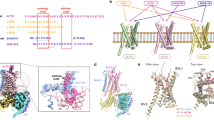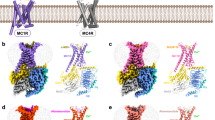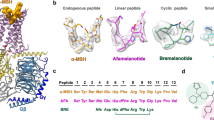Abstract
Most of our understanding of G protein–coupled receptor (GPCR) activation has been focused on the direct interaction between diffusible ligands and their seven-transmembrane domains. However, a number of these receptors depend on their extracellular N-terminal domain for ligand recognition and activation. To dissect the molecular interactions underlying both modes of activation at a single receptor, we used the unique properties of the melanocortin-4 receptor (MC4R), a GPCR that shows constitutive activity maintained by its N-terminal domain and is physiologically activated by the peptide α-melanocyte stimulating hormone (αMSH). We find that activation by the N-terminal domain and αMSH relies on different key residues in the transmembrane region. We also demonstrate that agouti-related protein, a physiological antagonist of MC4R, acts as an inverse agonist by inhibiting N terminus–mediated activation, leading to the speculation that a number of constitutively active orphan GPCRs could have physiological inverse agonists as sole regulators.
This is a preview of subscription content, access via your institution
Access options
Subscribe to this journal
Receive 12 print issues and online access
$259.00 per year
only $21.58 per issue
Buy this article
- Purchase on Springer Link
- Instant access to full article PDF
Prices may be subject to local taxes which are calculated during checkout



Similar content being viewed by others
References
Kristiansen, K. Molecular mechanisms of ligand binding, signaling, and regulation within the superfamily of G-protein–coupled receptors: molecular modeling and mutagenesis approaches to receptor structure and function. Pharmacol. Ther. 103, 21–80 (2004).
Kobilka, B.K. G protein–coupled receptor structure and activation. Biochim. Biophys. Acta 1768, 794–807 (2007).
Lagerström, M.C. & Schiöth, H.B. Structural diversity of G protein–coupled receptors and significance for drug discovery. Nat. Rev. Drug Discov. 7, 339–357 (2008).
Scarborough, R.M. et al. Tethered ligand agonist peptides. Structural requirements for thrombin receptor activation reveal mechanism of proteolytic unmasking of agonist function. J. Biol. Chem. 267, 13146–13149 (1992).
Vassart, G., Pardo, L. & Costagliola, S. A molecular dissection of the glycoprotein hormone receptors. Trends Biochem. Sci. 29, 119–126 (2004).
Breit, A. et al. Alternative G protein coupling and biased agonism: new insights into melanocortin-4 receptor signalling. Mol. Cell. Endocrinol. 331, 232–240 (2011).
Bromberg, Y., Overton, J., Vaisse, C., Leibel, R.L. & Rost, B. In silico mutagenesis: a case study of the melanocortin 4 receptor. FASEB J. 23, 3059–3069 (2009).
Srinivasan, S. et al. Constitutive activity of the melanocortin-4 receptor is maintained by its N-terminal domain and plays a role in energy homeostasis in humans. J. Clin. Invest. 114, 1158–1164 (2004).
Seifert, R. & Wenzel-Seifert, K. Constitutive activity of G-protein–coupled receptors: cause of disease and common property of wild-type receptors. Naunyn Schmiedebergs Arch. Pharmacol. 366, 381–416 (2002).
Tolle, V. & Low, M.J. In vivo evidence for inverse agonism of Agouti-related peptide in the central nervous system of proopiomelanocortin-deficient mice. Diabetes 57, 86–94 (2008).
Peter, J.C. et al. Antibodies against the melanocortin-4 receptor act as inverse agonists in vitro and in vivo. Am. J. Physiol. Regul. Integr. Comp. Physiol. 292, R2151–R2158 (2007).
Ollmann, M.M. et al. Antagonism of central melanocortin receptors in vitro and in vivo by agouti-related protein. Science 278, 135–138 (1997).
Fan, W., Boston, B.A., Kesterson, R.A., Hruby, V.J. & Cone, R.D. Role of melanocortinergic neurons in feeding and the agouti obesity syndrome. Nature 385, 165–168 (1997).
Nijenhuis, W.A., Oosterom, J. & Adan, R.A. AgRP(83–132) acts as an inverse agonist on the human-melanocortin-4 receptor. Mol. Endocrinol. 15, 164–171 (2001).
Chai, B.X. et al. Inverse agonist activity of agouti and agouti-related protein. Peptides 24, 603–609 (2003).
Costa, T. & Herz, A. Antagonists with negative intrinsic activity at delta opioid receptors coupled to GTP-binding proteins. Proc. Natl. Acad. Sci. USA 86, 7321–7325 (1989).
Kenakin, T. Efficacy as a vector: the relative prevalence and paucity of inverse agonism. Mol. Pharmacol. 65, 2–11 (2004).
Patel, M.P. et al. Loop-swapped chimeras of the agouti-related protein and the agouti signaling protein identify contacts required for melanocortin 1 receptor selectivity and antagonism. J. Mol. Biol. 404, 45–55 (2010).
Ballesteros, J.A. & Weinstein, H. Integrated methods for the construction of three-dimensional models and computational probing of structure-function relations in G protein–coupled receptors. Methods Neurosci. 25, 366–428 (1995).
Lubrano-Berthelier, C. et al. Melanocortin 4 receptor mutations in a large cohort of severely obese adults: prevalence, functional classification, genotype-phenotype relationship, and lack of association with binge eating. J. Clin. Endocrinol. Metab. 91, 1811–1818 (2006).
Calton, M.A. et al. Association of functionally significant Melanocortin-4 but not Melanocortin-3 receptor mutations with severe adult obesity in a large North American case-control study. Hum. Mol. Genet. 18, 1140–1147 (2009).
Haskell-Luevano, C., Cone, R.D., Monck, E.K. & Wan, Y.P. Structure activity studies of the melanocortin-4 receptor by in vitro mutagenesis: identification of agouti-related protein (AGRP), melanocortin agonist and synthetic peptide antagonist interaction determinants. Biochemistry 40, 6164–6179 (2001).
Jongejan, A. et al. Linking ligand binding to histamine H1 receptor activation. Nat. Chem. Biol. 1, 98–103 (2005).
Pellissier, L.P. et al. Conformational toggle switches implicated in basal constitutive and agonist-induced activated states of 5–HT4 receptors. Mol. Pharmacol. 75, 982–990 (2009).
Holst, B. et al. A conserved aromatic lock for the tryptophan rotameric switch in TM-VI of seven-transmembrane receptors. J. Biol. Chem. 285, 3973–3985 (2010).
Choe, H.W. et al. Crystal structure of metarhodopsin II. Nature 471, 651–655 (2011).
Standfuss, J. et al. The structural basis of agonist-induced activation in constitutively active rhodopsin. Nature 471, 656–660 (2011).
Xu, F. et al. Structure of an agonist-bound human A2A adenosine receptor. Science 332, 322–327 (2011).
Warne, T. et al. The structural basis for agonist and partial agonist action on a β1-adrenergic receptor. Nature 469, 241–244 (2011).
Rasmussen, S.G. et al. Structure of a nanobody-stabilized active state of the β2 adrenoceptor. Nature 469, 175–180 (2011).
Rosenbaum, D.M. et al. Structure and function of an irreversible agonist-β2 adrenoceptor complex. Nature 469, 236–240 (2011).
Shi, L. et al. β2 adrenergic receptor activation. Modulation of the proline kink in transmembrane 6 by a rotamer toggle switch. J. Biol. Chem. 277, 40989–40996 (2002).
Swaminath, G. et al. Probing the 2 adrenoceptor binding site with catechol reveals differences in binding and activation by agonists and partial agonists. J. Biol. Chem. 280, 22165–22171 (2005).
Civelli, O. GPCR deorphanizations: the novel, the known and the unexpected transmitters. Trends Pharmacol. Sci. 26, 15–19 (2005).
Bond, R.A. & Ijzerman, A.P. Recent developments in constitutive receptor activity and inverse agonism, and their potential for GPCR drug discovery. Trends Pharmacol. Sci. 27, 92–96 (2006).
Chen, G. et al. Use of constitutive G protein–coupled receptor activity for drug discovery. Mol. Pharmacol. 57, 125–134 (2000).
Behan, D.P. & Chalmers, D.T. The use of constitutively active receptors for drug discovery at the G protein–coupled receptor gene pool. Curr. Opin. Drug Discov. Devel. 4, 548–560 (2001).
Toyooka, M., Tujii, T. & Takeda, S. The N-terminal domain of GPR61, an orphan G-protein–coupled receptor, is essential for its constitutive activity. J. Neurosci. Res. 87, 1329–1333 (2009).
Lubrano-Berthelier, C. et al. Intracellular retention is a common characteristic of childhood obesity–associated MC4R mutations. Hum. Mol. Genet. 12, 145–153 (2003).
Vaisse, C. et al. Melanocortin-4 receptor mutations are a frequent and heterogeneous cause of morbid obesity. J. Clin. Invest. 106, 253–262 (2000).
Acknowledgements
This work was supported by US National Institutes of Health (NIH) grant DK60540 and an American Heart Association Established Investigator Award to C.V., NIH DK064265 to G.M., an American Heart Association Predoctoral Fellowship and NIH National Research Service Award Endocrinology Training Grant to B.A.E. and a Spanish Ministry of Science and Innovation Award (SAF2010-22198-C02-02) to L.P. C.G. is funded as a Chercheur Qualifié by the Fonds National de la Recherche Scientifique. We would like to thank H. Bourne, B. Conklin and G. Vassart for reviewing the initial version of the manuscript and providing insightful comments.
Author information
Authors and Affiliations
Contributions
B.A.E. contributed to the hypothesis, designed and performed experiments, analyzed data and wrote the manuscript. L.P. designed and performed computational experiments, analyzed data and wrote the manuscript. S.Z. performed experiments. D.A.T. contributed to the hypothesis, and designed and performed experiments. G.M. contributed to the hypothesis, and provided reagents and expertise. C.G. contributed to the hypothesis, designed experiments and wrote the manuscript, and C.V. contributed to the hypothesis, directed the work, designed experiments and wrote the manuscript.
Corresponding author
Ethics declarations
Competing interests
The authors declare no competing financial interests.
Supplementary information
Supplementary Text and Figures
Supplementary Methods and Supplementary Results (PDF 4902 kb)
Rights and permissions
About this article
Cite this article
Ersoy, B., Pardo, L., Zhang, S. et al. Mechanism of N-terminal modulation of activity at the melanocortin-4 receptor GPCR. Nat Chem Biol 8, 725–730 (2012). https://doi.org/10.1038/nchembio.1008
Received:
Accepted:
Published:
Issue Date:
DOI: https://doi.org/10.1038/nchembio.1008
This article is cited by
-
Fly casting with ligand sliding and orientational selection supporting complex formation of a GPCR and a middle sized flexible molecule
Scientific Reports (2022)
-
Amino terminal recognition by a CCR6 chemokine receptor antibody blocks CCL20 signaling and IL-17 expression via β-arrestin
BMC Biotechnology (2021)
-
The N-terminus of GPR37L1 is proteolytically processed by matrix metalloproteases
Scientific Reports (2020)
-
Subcellular localization of MC4R with ADCY3 at neuronal primary cilia underlies a common pathway for genetic predisposition to obesity
Nature Genetics (2018)
-
Ligand chain length drives activation of lipid G protein-coupled receptors
Scientific Reports (2017)



